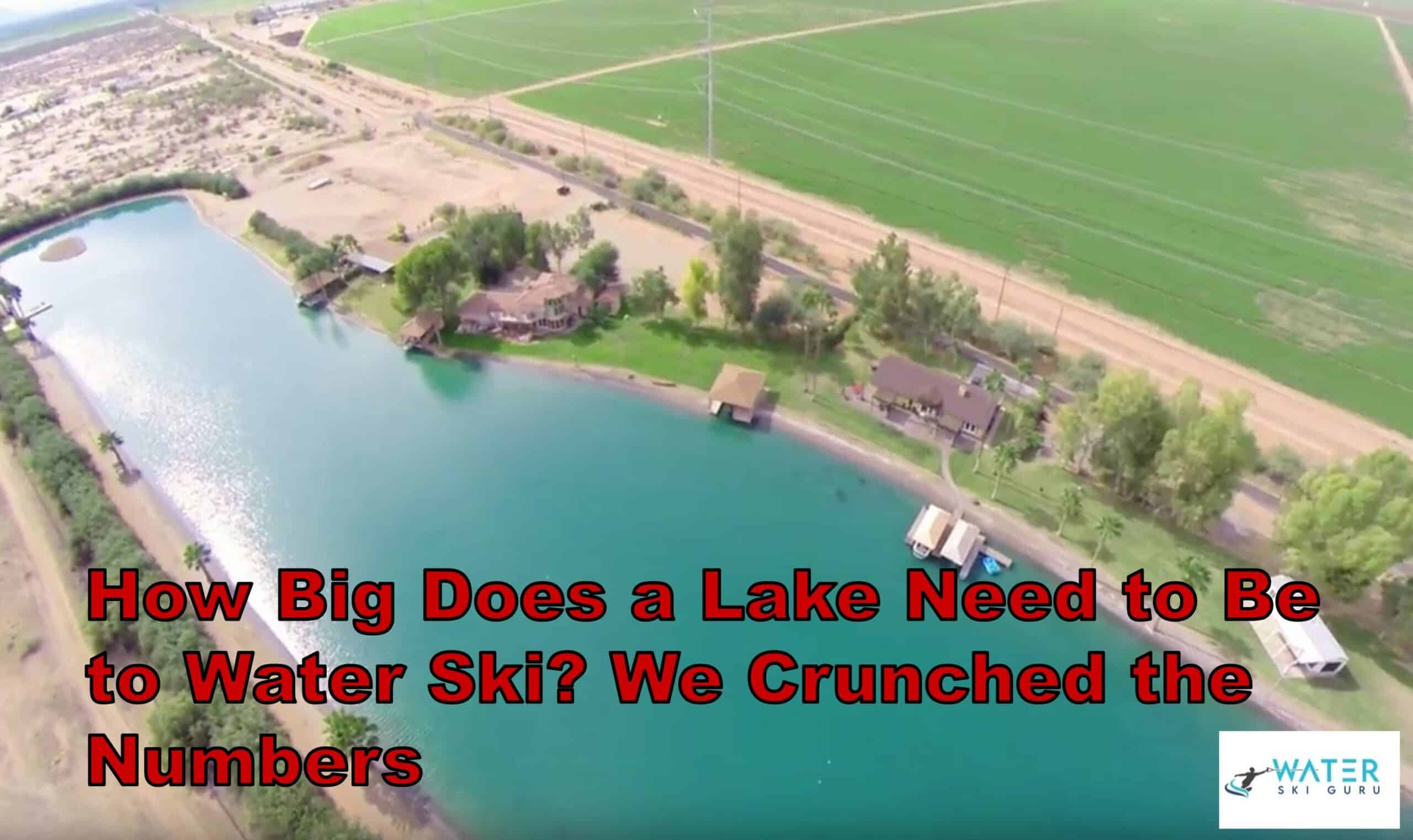Water skiing can be done on many kinds of water surfaces, such as rivers, oceans, or, the more popular option, lakes.
There are hundreds of naturally formed lakes around the US, but not all of them are suitable for water sports. In order to deem a lake good enough for water skiing, it needs to be wide enough and deep enough to be safe for skiing.
Even with these rules, you can still find plenty of lakes to use as a skier. But what if, just what if, you decide to build your own private lake? Is it possible? Yes, it is. But it is also a lot more work than you can ever imagine.
How big does a lake need to be to water ski? An average water ski lake needs to be at least 2200 feet x 200 feet wide. This will give the boats enough space to turn around safely and comfortably while the wakes dissipate. The lake also needs to be no less than 5 feet deep to allow safe skiing.
So if you are a regular water skier, should you consider building your own private lake? What are the rules and regulations of acquiring your own lake, and is it actually worth it, or should you just stick to public lakes? Keep reading to find out.
How Big Does a Lake Need to Be to Water Ski?
An average private lake needs to be 2200 feet x 200 feet wide to allow water skiing. Natural lakes can be a lot bigger than private lakes and will allow more skiers to use them at the same time without the danger of accidents.
The size of the lake should be big enough to let the boat turn around easily. Adding a turning island at both ends of the lake can make that process easier.
How Deep Does a Water Ski Lake Need to Be?
A water skiing lake should not be less than 5 feet deep. Water skiing does not need incredibly deep water. Still, shallow lakes risk the formation of algae, which can cause slipping accidents while skiing. A deep lake is also safer in case of collision as the earth is not close enough to break bones upon falling.
How to Build Your Private Water Ski Lake?
Building a private Water Ski lake can be a lot of work that will not just take you a couple of months to complete but maybe years to get it right.
There are many factors that you need to consider when deciding to go on with a project this huge, including whether you should do it alone or bring in some partners, where you should dig this lake, what natural factors you should consider, and many more questions.
We will give you a comprehensive checklist of the main questions you need to keep in mind while building your lake. As long as these factors are available to you and meet the required criteria, then you are good to go.
Solo or Group Venture?
Investing in land and building property, whether it be a lake or an apartment building, is a huge financial risk and can break your bank and leave you dry. The good thing is, you don’t have to do it alone.
Many people want to build their own Water Ski lake, whether it is to actively participate in the activity or for investment reasons. Either way, this fact means the financial risk and amount of work needed can be divided among multiple partners, making it easier to handle.
The downside of turning this into a group project is the increasing opinions and all the problems that come with having partners. You will no longer have the final say, and you will have to share all your decision -and eventually- your lake with other people.
So, make sure to assess the pros and cons of doing it solo or in a group before you make your final decision.
What Kind of Land Do You Need and Where?
After deciding on how to finance your project, you need to start looking for land. Your land is the base of your entire project; it needs to meet many criteria to be suitable for digging and maintaining a lake.
Not every type of land is suitable for digging a lake, and this has nothing to do with its size.
- First, you need low-lying land, which means land at or below sea level. A low-lying land will allow the natural flow of water, whether it comes from rain or a nearby natural and legal water source, to actually reach your lake.
- The second thing you need to consider is the soil type. Not every soil can actually be dug up and filled with water. Clay soil is the best option for building a lake, while rocky or sandy soil can break your project and require you to buy suitable soil for your land. Commissioning a soil report by an engineer is a crucial first step, even before you consider buying this land.
- The final thing you need to consider concerning your land is its location, which will affect its price and accessibility. A 100-acre land in Colorado will be much cheaper than a 100-acre land in New York or Los Angeles. The further you are from the city, the cheaper and easier it will be to find suitable land. Still, you also need to consider roads and safety as you go further.
Choosing the perfect piece of land will take time and research, but it’s arguably the most important step. So give it deep thought and don’t rush into it.
Where Is Your Water Source?
One of the steps to find good land for your lake ensuring is a usable natural water source nearby. If you have a 100-acre lake, you are definitely not going to fill it with a garden hose. Instead, you will need to locate a nearby river, ocean, or underground water source that is legal for public use.
You can also source your water through a watershed, which is an area of land that feeds all the water in the area, including rain, into your body of water. When you consider your watershed, you need to make sure it is the right size for your lake. It needs to be big enough to fill the lake but not too big that you don’t have enough space for the water.
How Much Will the Lake Cost You?
Now the biggest question is, can you even afford to do this?
You need to break down all the costs of the entire project to a rough estimate before you even start. For example, consider the price of the land and the cost of all the permits you will need to buy your land, dig your lake, use the public water source, and all the construction that will take place.
You will need to pay an engineer and workers and buy or rent a lot of equipment. Then you have to consider your water skiing equipment costs: the boat, the skis, the ski course, and the boat house.
All of this can cost you an average of 1 million dollars or more for 15 acres of lake, depending on your location.
Can You Water Ski on Any Lake?
You can ski on any lake that is legal for skiing and has an appropriate size to ensure safety measures.
As mentioned before, a water ski lake needs to have at least a 200 feet wide skiing space, and the water should be at least 5 to 6 feet deep. This space will give skiers enough room to safely get up and the boat operators enough space to avoid accidents and maneuver easily around the lake.
Here are some of the most famous and popular skiing lake destinations around the US:
- Lake Michigan (Accessible through multiple states) – Lake Michigan is a huge lake that is accessible from multiple states. It includes many beaches, and it is very easy to find boats and ski equipment to rent on its shores.
- Lake Havasu (Arizona) – Lake Havasu is a man-made reservoir on the border of California. Even though Arizona is known for its desert, Lake Havasu is a very popular skiing destination in the US.
- Lake Cumberland (Kentucky) – Located in Kentucky, Lake Cumberland is a 1255 miles lake that is a great skiing spot. It has full-service marinas where you can rent equipment and a boat for your skiing adventure.
- Lake Tahoe (California and Nevada) – One of the most popular lakes in the US, Lake Tahoe is a great place for camping and skiing. It’s too cold during the winter, but the summer temperature is perfect for escaping from the heat. Equipment and boats are also available along its many beaches.
- Lake Texoma (Texas) – Lake Texoma is a family-friendly destination with 12 marinas scattered around the huge lake. It’s one of the biggest lakes in the US and an exciting place to water ski. It also offers many activities besides skiing, like vacation houses and fishing.
Where Can You Not Water Ski?
As a general rule, you should avoid water skiing in too shallow water. Water skiing does not require incredibly deep water, but anything less than 5 feet deep can be dangerous in case of a fall. Another rule is to make sure there is enough space between you and any other skier on the lake. If the lake is small, then only one boat can access it at a time.
Related Questions
How Big Is a Private Ski Lake?
There is no definite size for private lakes, but most lakes are 2200 feet x 200 feet. This size allows the boat to turn around comfortably. The bigger the private lake, the more expensive it is to build, but also the more boats and skiers it can take at the same time.
How Many Acres Do You Need for a Ski Lake?
You will need an average of 25 acres of land to build a ski lake. The lake itself will not take all 25 acres, of course; it may be about 15 acres, give or take. The rest of the land will house your boat house and enough spectators to stand and store their equipment.
What Is the Smallest Size for a Lake?
The smallest lake is 5 acres wide. Anything smaller than 5 acres will be considered a pond. A 5-acre lake is usually not very deep; if it is even smaller, it will be shallower. Small lakes can be natural or man-made for aesthetic reasons.

